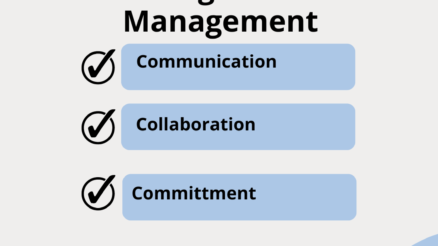In the ever-changing business world, effective change management is the key that drives businesses to success.
Change management practitioners employ various frameworks, models, and strategies to successfully execute organizational change
4-eye check process in change management is a crucial mechanism that guides change efforts to be executed smoothly and lead to lasting results.
This process acts as a safeguard, fortifying decision-making, minimizing risks, and promoting collaboration among stakeholders.
In this blog post, we’ll dive into the details of the 4-eye check process in change management, exploring its importance, main elements, ways to put it into practice, and the various advantages it brings to organizations dealing with the often-challenging process of change.
Let’s learn more about it
What is change management?
Change management refers to the structured process and set of tools employed to lead individuals, teams, and organizations through a deliberate transition from the current state to a desired future state.
This could involve changes in processes, organizational structure, technology, culture, or any other aspect of an organization.
The goal of change management is to minimize resistance and ensure that the changes are implemented smoothly and effectively, ultimately achieving the desired outcomes and benefits.
What is 4-eye check process?
The 4-eye check process typically refers to a quality control or validation step where two sets of eyes, or two individuals, review and approve a decision, document, or process.
This approach is also known as a “two-person integrity” check and is often implemented to enhance accuracy, reduce errors, and increase accountability in various contexts, including change management.
Understanding the 4-Eye Check Process in Change Management
The 4-eye check process is a systematic and collaborative approach to decision-making and quality assurance, particularly prevalent in change management.
The term 4-eye implies the involvement of two individuals, emphasizing the necessity of a second set of eyes to review and validate key aspects of a proposed change before implementation.
The 4-eye check process is a structured and teamwork-based method often used in change management.
The term 4-eye means two people are involved, emphasizing the need for a second set of eyes to carefully review and approve critical parts of a proposed change before putting it into action.
This method acts as a safeguard against oversight, errors, and potential risks by requiring the input of two stakeholders, each contributing unique insights to ensure the change aligns with organizational objectives.
The Role of Collaboration in Change Management
Collaboration is a fundamental aspect of successful change management, and the 4-eye check process is a prime example of this idea.
By bringing together different viewpoints, collaboration creates a collective intelligence that goes beyond individual perspectives. It involves various people, from team members to leaders, to make sure everyone understands the proposed change.
This collaborative approach not only enhances the decision-making process but also cultivates a sense of ownership and alignment among those affected by the change.
Key Components of the 4-Eye Check Process in Change Management
Following are the key components of 4 eye check process in change management.
1. Identification of Stakeholders
Stakeholder identification is a foundational step in the 4-eye check Process, crucial for understanding the diverse perspectives that should be considered during the evaluation of a proposed change.
Identifying key stakeholders involves recognizing individuals, groups, or entities that can directly or indirectly influence, or be influenced by, the change.
This may include internal stakeholders such as employees at various levels, managers, executives, and external stakeholders such as customers, suppliers, and regulatory bodies.
This entire identification of stakeholders is usually done through change management stakeholder mapping method.
Understanding their roles in the change process
Once identified, it’s imperative to delve into the roles and responsibilities of each stakeholder in the change process.
This understanding helps in assessing how the proposed change might impact different stakeholders and how their perspectives contribute to the overall evaluation.
For example, front-line employees may offer insights into the practical aspects of implementation, while executives may provide strategic viewpoints.
Recognizing these roles ensures that the 4-eye check process incorporates a diverse range of expertise, fostering a holistic and well-rounded evaluation of the proposed change.
2. Assessment of Risks and Benefits
Assessing the risks and benefits associated with a proposed change is a critical component of the 4-eye check process, providing a comprehensive understanding of the potential impact on the organization.
Identifying potential risks associated with the change
Identify potential risks to the organization’s overall strategy and goals. Assess how the change aligns with the long-term vision and whether it introduces strategic vulnerabilities.
Examine how the change may affect daily operations. Recognize potential disruptions, resource limitations, or logistical challenges that could hinder successful implementation.
Evaluate the financial implications of the change, including upfront costs, ongoing expenses, and potential revenue impacts. Identify any uncertainties that could pose financial risks.
Evaluating the anticipated benefits of the change
Examine how the change aligns with the organization’s strategic objectives. Identify potential gains in market positioning, competitive advantage, or industry leadership.
Assess how the change improves efficiency, productivity, and overall operational effectiveness. Consider any enhancements to processes or workflows that contribute to organizational success.
Evaluate the expected financial returns and benefits. This includes revenue growth, cost savings, and other financial improvements resulting from the change.
Consider the impact on the workforce and organizational culture. Identify potential improvements in employee satisfaction, engagement, and alignment with the organization’s values.
The 4-eye check ensures that the assessment of risks and benefits is thorough and unbiased, with two sets of eyes critically examining the potential outcomes of the proposed change.
This process not only highlights areas of concern but also validates the expected benefits, contributing to a more informed decision-making process.
3. Critical Evaluation of the Change Plan
Examining the change plan is a critical part of the 4-eye check process, and it involves closely looking at the details of the proposed change. The goal is to make sure the plan fits well with the broader goals and objectives of the organization.
Check if the change plan is clear and makes sense. Ensure that the goals, strategies, and action steps are well-defined and logically connected.
Evaluate the feasibility of the proposed change. Consider whether the plan takes into account available resources, timelines, and potential obstacles. Identify any aspects of the plan that may be overly ambitious or unrealistic.
Confirm that the change plan incorporates input from relevant stakeholders. A well-rounded plan considers diverse perspectives, increasing the likelihood of successful implementation.
4. Ensuring Compliance and Best Practices
Ensuring compliance with industry best practices and legal regulations is a fundamental aspect of the 4-eye check process.
This step aims to guarantee that the proposed change plan not only aligns with internal organizational goals but also meets external standards and obligations.
Consider lessons learned from past organizational changes or industry case studies. Ensure that the change plan integrates insights from both internal and external sources to optimize effectiveness.
Conduct a thorough legal review of the change plan. Ensure that it complies with all applicable laws, regulations, and contractual obligations. Identify any potential legal risks and address them proactively.
Verify that the change plan adheres to industry-specific regulations. This is particularly crucial in regulated industries such as finance, healthcare, or environmental services, where non-compliance can have severe consequence
Who are responsible for 4-Eye Check Process in Change Management
It’s important to note that the specific individuals involved will depend on the nature and scope of the change initiative.
The goal is to assemble a team that collectively covers all relevant aspects of the change and brings diverse perspectives to the evaluation process.
The involvement of diverse perspectives is key to the success of the 4 eye check.
Here are key roles that should be considered:
- Change Sponsor or Leader:
- Role: The person responsible for overseeing the entire change initiative.
- Involvement: Essential for providing context, strategic alignment, and overall leadership perspective.
- Technical Experts:
- Role: Individuals with specialized knowledge relevant to the change.
- Involvement: Offers insights into the technical, operational, or functional aspects of the proposed change.
- Project Managers:
- Role: Those responsible for planning and executing the change initiative.
- Involvement: Ensures the practicality and feasibility of the proposed change plan.
- Departmental Managers/Leaders:
- Role: Leaders from affected departments or units.
- Involvement: Provides insights into how the change may impact day-to-day operations and team dynamics.
- Human Resources (HR) Representatives:
- Role: HR professionals who understand the people aspects of change.
- Involvement: Ensures consideration of employee concerns, cultural impact, and alignment with HR policies.
- Risk Management Experts:
- Role: Individuals with expertise in risk assessment and management.
- Involvement: Focuses on identifying and mitigating potential risks associated with the change.
- Communication Specialists:
- Role: Experts in internal and external communication.
- Involvement: Ensures that communication plans are effective, transparent, and aligned with organizational messaging.
- Legal and Compliance Experts:
- Role: Individuals well-versed in legal and regulatory requirements.
- Involvement: Verifies that the change plan complies with laws and regulations.
- Diversity and Inclusion Representatives:
- Role: Individuals focused on promoting diversity and inclusion.
- Involvement: Ensures that the change plan considers diverse perspectives and potential impacts on different demographic groups.
Benefits of the 4-Eye Check Process in Change Management
The 4-eye check process in change management yields man benefits that contribute to the overall success and sustainability of organizational transformations.
Here are key advantages associated with the implementation of the 4-eye check:
A. Enhanced Decision-Making
The involvement of two sets of eyes brings diverse perspectives to the decision-making process.
This diversity enhances the quality of decisions by incorporating a broader range of insights, experiences, and expertise. The 4-eye check helps mitigate individual biases that may influence decision-making.
With multiple viewpoints, decisions are more likely to be objective, thorough, and reflective of the organization’s best interests.
B. Risk Mitigation
The dual scrutiny inherent in the 4-eye check facilitates a more comprehensive assessment of potential risks associated with the proposed change.
This proactive approach allows for the identification and mitigation of risks before they escalate. By identifying risks early in the process, the 4-eye check enables organizations to develop robust contingency plans.
This ensures a more agile response to unforeseen challenges, minimizing disruptions during implementation.
C. Improved Communication and Collaboration
The 4-eye check necessitates communication and collaboration among stakeholders.
This involvement fosters a culture of openness and inclusivity, ensuring that the perspectives of all relevant parties are considered.
The process encourages the sharing of knowledge and expertise among individuals involved in the 4-eye check. This knowledge exchange contributes to a better understanding of the change and its potential impact.
D. Ensuring Sustainable Change
The rigorous evaluation conducted during the 4-eye check ensures that the proposed change aligns with the organization’s overarching goals and objectives.
This alignment enhances the likelihood of sustained success. The feedback loop established by the 4-Eye Check promotes a culture of continuous improvement.
Insights gained from the evaluation process can be used to refine change management strategies, contributing to long-term organizational adaptability.
Final Words
The 4-eye check process plays a pivotal role in successful implementation of change. It’s like having a trusty co-pilot on the journey of change. It improves decision making and helps to mitigate risks. It’s a crucial step in making sure everything runs smoothly. When organizations pick the right people for this job early on, it’s like setting the stage for a successful change initiative from the onset.



